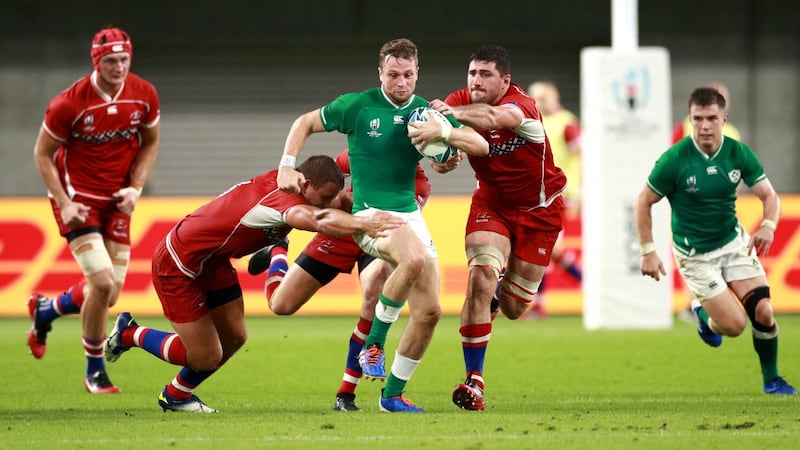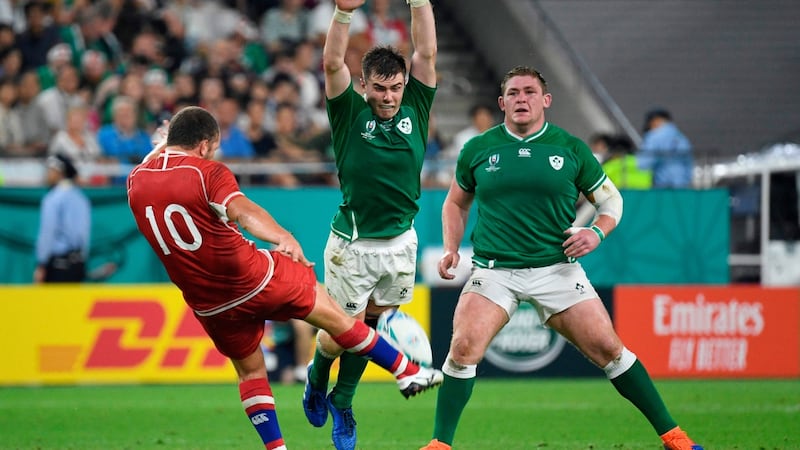A five-try, bonus-point win against a Russian team that played 20 minutes with 14 players will feel underwhelming, especially given the nature of the contest; an error-strewn, fitful performance in which Ireland were once again conspicuously inhibited at times in orientation and execution. Handling mistakes proved a real bugbear.
An injury to Jordi Murphy and the fact that Joey Carbery's ankle issue flared up forcing him to withdraw ahead of kick-off are other legacies from the contest. The hoped for momentum heading to the Samoa game in nine days time is more zephyr than hurricane. The rest period will hopefully provide a salve for tired minds and limbs.
There is some mitigation in the conditions, humidity and a slippery ball but the review will be a tough watch in terms of general play. Not for all mind you. John Ryan's work rate on both sides of the ball was excellent, Rhys Ruddock was outstanding, Peter O'Mahony and Dave Kilcoyne had their moments, Luke McGrath's energy and speed was notable while there were standout moments for virtually everyone in a predominantly underutilised backline, in which Andrew Conway was the standout contributor.

Attack
Ireland were very narrow at times in attack, a flaw that has permeated performances in which they have struggled to break down teams. They expend a great deal of energy for minimal gain and given the conditions and slippery ball, charging into cluttered human corridors introduces a far greater risk of turnovers; Ireland made 18 handling errors.
There are times when the ball has to be carried, hard and direct initially but there were multiple occasions when Ireland might have sought out space in the wider channels to maximise a return from the footwork and pace of players like Conway, Keith Earls and Garry Ringrose in particular. They operated on the periphery of the attacking patterns rather than being centrally employed.
In two previous World Cup matches, Russia had a tackle completion rate of 75 per cent against Japan and 70 per cent against Samoa. In their defeat to Ireland it jumped to just a smidgeon under 89 per cent (182/21). This was a Russian side that made 11 changes so without denigrating their effort, it suggests that Ireland were much easier to read and in many respects corral, the five tries notwithstanding.
Shape
Joe Schmidt's side had a better shape with Johnny Sexton at the helm, as would be expected, his experience, game management and organisational skills very obvious in the first 20 minutes. Jack Carty, winning his 10th cap, is a tyro in international terms but given the injury issues surrounding the 10 jersey, Ireland need to fast-track his development into an outhalf that can run a Test match with authority.

It’s a tough remit and a slightly unfair expectation but that’s the immediate challenge. No one can question his temperament - he recovered from a shaky start to contribute to two of Ireland’s five tries with a chip over the top and a quick, well placed dropout - or his ability, but when called upon he needs to stick his chest out and boss his team and the game.
Passing
There was a fair bit of lateral shovelling going on and while the slippery ball is a consideration it doesn’t fully excuse why on several occasions Irish players didn’t straighten, attack inside shoulders and commit defenders rather than allowing the Russians to shepherd them to a touchline with minimal inconvenience.
Closer-in it was relatively easy to identify the likely Irish ball carrier from ruck possession and therefore straightforward to defend. There needs to be greater animation, depth at which players come onto the ball at times and options, for Ireland to ensure gain-lines and quicker ball that will allow them to rattle through the phases, all the while making metres and physically edging the collisions.
Russian kicking game
A chapeau tip to Russian outhalf Ramil Gaisin for his towering cross-kicks that allowed three Russian chasers to surround the Irish catcher and win turnover ball at the ensuing ruck on several occasions; limited but very effective and one that will have been noted by future opponents.

Ireland kicking game
It was largely very good. Sexton's grubber for O'Mahony's try, Carty's chip for Conway's try and his quick drop-out for Ringrose's try. Conway and Rob Kearney, Sexton in general also put boot to ball intelligently while McGrath's box-kicking produced a 50 per cent return from six attempts.






















